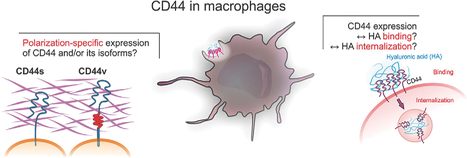当前位置:
X-MOL 学术
›
Adv. Healthcare Mater.
›
论文详情
Our official English website, www.x-mol.net, welcomes your
feedback! (Note: you will need to create a separate account there.)
The CD44‐Mediated Uptake of Hyaluronic Acid‐Based Carriers in Macrophages
Advanced Healthcare Materials ( IF 10.0 ) Pub Date : 2016-12-19 , DOI: 10.1002/adhm.201601012
Julio M Rios de la Rosa 1 , Annalisa Tirella 1 , Arianna Gennari 1 , Ian J Stratford 1 , Nicola Tirelli 1
Advanced Healthcare Materials ( IF 10.0 ) Pub Date : 2016-12-19 , DOI: 10.1002/adhm.201601012
Julio M Rios de la Rosa 1 , Annalisa Tirella 1 , Arianna Gennari 1 , Ian J Stratford 1 , Nicola Tirelli 1
Affiliation

|
CD44 is a potentially rewarding target in cancer therapy, although its mechanisms of ligand binding and internalization are still poorly understood. In this study, we have established quantitative relationships between CD44 expression in differently polarized macrophages (M0, M1, and M2‐polarized THP‐1 human macrophages) and the uptake of hyaluronic acid (HA)‐based materials, which are potentially usable for CD44 targeting. We have validated a robust method for macrophage polarization, which sequentially uses differentiating and polarizing factors, and allows to show that CD44 expression depends on polarization (M1 > M0 ≥ M2). It is noteworthy that THP‐1 M2 expressed CD44v6, suggesting their suitability as a model of tumor‐associated macrophages. In the uptake of HA, both as a soluble polymer and in the form of (siRNA‐loaded) nanoparticles, CD44 expression correlated positively with binding, but negatively with internalization. Counterintuitively, it appears that a higher presence of CD44 (in M1) allows a more efficient capture of HA materials, but a lower expression (in M2) is conducive to better internalization. Although possibly cell‐specific, this unexpected relationship indicates that the common paradigm “higher CD44 expression = better targetability” is too simplistic; mechanistic details of both receptor presentation and association still need to be elucidated for a predictable targeting behavior.
中文翻译:

CD44 介导的巨噬细胞对透明质酸载体的摄取
CD44 是癌症治疗中一个潜在的有益靶点,尽管其配体结合和内化机制仍知之甚少。在这项研究中,我们建立了不同极化巨噬细胞(M0、M1 和 M2 极化 THP-1 人巨噬细胞)中 CD44 表达与透明质酸 (HA) 基材料的摄取之间的定量关系,这些材料可能可用于 CD44瞄准。我们验证了一种稳健的巨噬细胞极化方法,该方法依次使用分化和极化因子,并可以证明 CD44 表达取决于极化 (M1 > M0 ≥ M2)。值得注意的是,THP-1 M2 表达 CD44v6,表明它们适合作为肿瘤相关巨噬细胞的模型。在 HA 的摄取中,无论是作为可溶性聚合物还是以(负载 siRNA 的)纳米颗粒的形式,CD44 表达与结合呈正相关,但与内化呈负相关。与直觉相反,CD44 的较高存在(在 M1 中)似乎可以更有效地捕获 HA 材料,但较低的表达(在 M2 中)有利于更好的内化。虽然可能是细胞特异性的,但这种意想不到的关系表明“CD44 表达越高=靶向性越好”这一常见范式过于简单化;为了实现可预测的靶向行为,仍需要阐明受体呈递和关联的机制细节。
更新日期:2016-12-19
中文翻译:

CD44 介导的巨噬细胞对透明质酸载体的摄取
CD44 是癌症治疗中一个潜在的有益靶点,尽管其配体结合和内化机制仍知之甚少。在这项研究中,我们建立了不同极化巨噬细胞(M0、M1 和 M2 极化 THP-1 人巨噬细胞)中 CD44 表达与透明质酸 (HA) 基材料的摄取之间的定量关系,这些材料可能可用于 CD44瞄准。我们验证了一种稳健的巨噬细胞极化方法,该方法依次使用分化和极化因子,并可以证明 CD44 表达取决于极化 (M1 > M0 ≥ M2)。值得注意的是,THP-1 M2 表达 CD44v6,表明它们适合作为肿瘤相关巨噬细胞的模型。在 HA 的摄取中,无论是作为可溶性聚合物还是以(负载 siRNA 的)纳米颗粒的形式,CD44 表达与结合呈正相关,但与内化呈负相关。与直觉相反,CD44 的较高存在(在 M1 中)似乎可以更有效地捕获 HA 材料,但较低的表达(在 M2 中)有利于更好的内化。虽然可能是细胞特异性的,但这种意想不到的关系表明“CD44 表达越高=靶向性越好”这一常见范式过于简单化;为了实现可预测的靶向行为,仍需要阐明受体呈递和关联的机制细节。

































 京公网安备 11010802027423号
京公网安备 11010802027423号